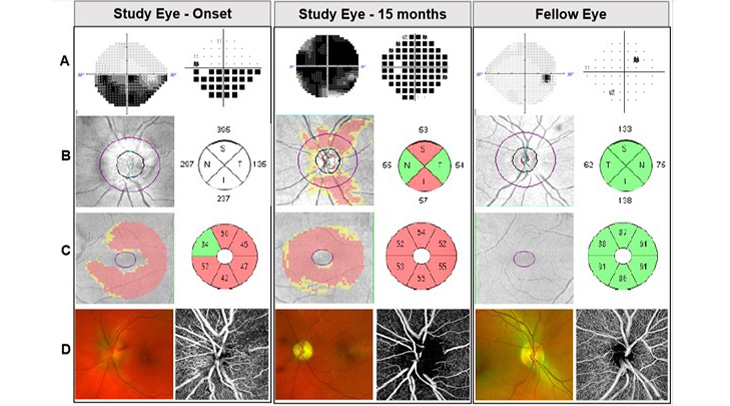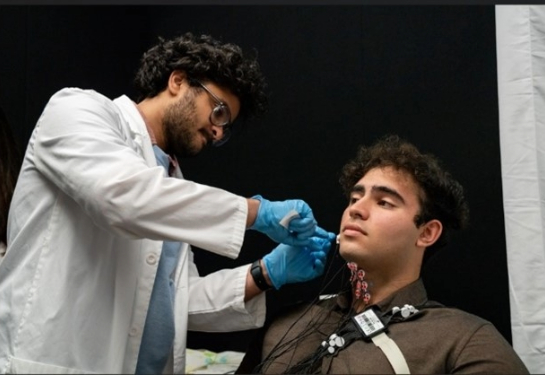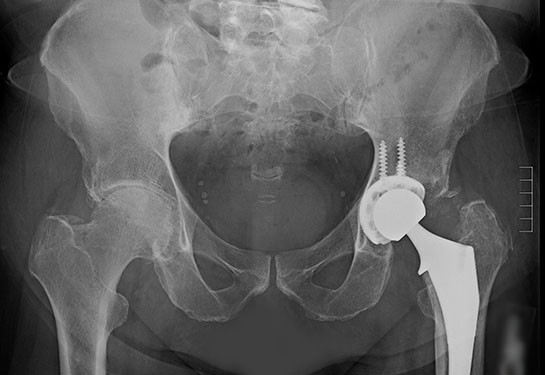New risk factor identified for potentially blinding condition
High altitude may put vision at risk for some individuals
Nonarteritic Anterior Ischemic Optic Neuropathy (NAION) is a relatively rare condition in which a loss of blood flow and oxygen delivery to the optic nerve cause sudden and painless vision loss in one eye. It is sometimes referred to as an eye stroke. Risk factors include advanced age, smoking, diabetes, high blood pressure, atherosclerosis, obstructive sleep apnea, certain medications and optic disc anatomy.
A small, single-center study published in the Journal of Neuro-Ophthalmology has revealed an additional risk factor: high altitude.
Yin Allison Liu, a neuro-ophthalmologist in the UC Davis departments of Ophthalmology & Vision Science, Neurology, and Neurosurgery, is the first author of the new paper. Liu conducted the research during her fellowship at Stanford University School of Medicine.
“Our study found that NAION can occur with high-altitude exposure, resulting in severe irreversible vision loss. All the cases in our study occurred at 7,000 to 9,000 feet above sea level and were associated with a relatively younger age at onset compared to the control group,” Liu said. “The visual outcome of High Altitude NAION (HA-NAION) is similar to NAION at normal altitude (NA-NAION).”
The impact of altitude on the eye
Previous research has shown that high altitude can affect the eyes in several ways. Periods of high-altitude exposure can lead to optic disc edema, cotton wool spots, and retinal vascular changes. One study of an extreme high-altitude expedition (11,500 to 18,000 feet) found 79% of all the climbers exhibited retinal hemorrhages.
The decreased amount of oxygen may play a role in HA-NAION. Although ambient air contains 20.9% oxygen at all altitudes, lower barometric pressure at higher altitudes causes hypobaric hypoxia, leading to an effectively lower percentage of O2. At about 8,000 feet above sea level in the Sierra Nevada, each breath contains 26% less oxygen than at sea level.
To find out if this high-altitude exposure could lead to NAION, the researchers studied 5 eyes of 5 patients who presented with vision loss within 2 weeks after exposure to high altitude.
The patients in the study did not have any major vascular risk factors, such as uncontrolled diabetes, hyperlipidemia, hypertension, prior ischemic or hemorrhagic strokes, transient ischemic attacks, or heart attacks.
These were compared to a control group of 28 patients with classic NAION that developed at sea level, and 40 controls. The researchers found that:
- All 5 patients with vision loss after high-altitude exposure had clinically confirmed NAION by a neuro-ophthalmologist within 3 to 21 days of onset and comprehensive follow-up evaluations.
- All 5 patients had disc-at-risk in the contralateral eye.
- 4 of the 5 patients had undiagnosed obstructive sleep apnea (apnea–hypopnea index 5.4 to 22.2), and one had existing systemic vascular risk factors.
- Visual outcomes were similar in patients with HA-NAION and NA-NAION.
The patients in the study with obstructive sleep apnea were fitted with continuous positive airway pressure (CPAP) machines to be used every time they slept and napped.
After addressing all NAION risk factors, no new events occurred in the HA-NAION group within 2 to 8 years with or without repeat high-altitude exposure.

Risk factors for NAION
The prevalence of NAION is between 2.3 and 10.3 people per 100,000, or about 6,000 new cases per year in the U.S. It is the most common acute optic neuropathy in those older than 50 years. No single mechanism has been definitively demonstrated. However, specific risk factors have been identified.
Up to 97% of patients with NAION have small optic discs with small or absent optic cups. Small cup-to-disc ratios (a measurement of structures where blood vessels enter the eye) are vulnerable to NAION. Small ratios, typically 0.2 or less, are also known as crowded discs or “disc-at-risk.” Disc-at-risk is the strongest risk factor for developing NAION.
Patients with obstructive sleep apnea also have a more than six-fold increased risk of NAION compared with individuals without sleep apnea.
High altitude appears to be a risk factor for patients who are already vulnerable. For example, when patients with untreated obstructive sleep apnea stay at high altitudes, hypobaric hypoxia may promote central sleep apnea and aggravate hypoxemia.
Other risk factors for NAION occurring at high altitude may include:
- altitude on starting of the ascent
- higher and faster ascent
- longer duration at high altitude
- lower hematocrit
- increased strenuous activities
- high baseline intraocular pressure
Liu notes that most commercial flights are pressurized to the equivalent of 6,000 to 8,000 feet elevation, meaning that a long flight may also be a risk factor for some patients. She is currently considering a multi-site study so that researchers can better understand the association between high-altitude exposure and NAION.
“Understanding the physiologic changes in patients at high risk before and after high-altitude exposure can help us more clearly identify changes that contribute to developing HA-NAION,” Liu said. “There is no effective treatment for NAION or HA-NAION at this time. Learning more about how to prevent it will help preserve vision for our patients.”
Resources




